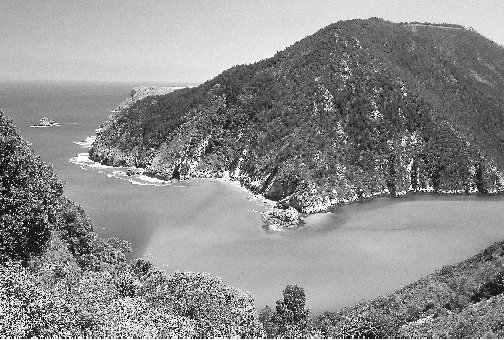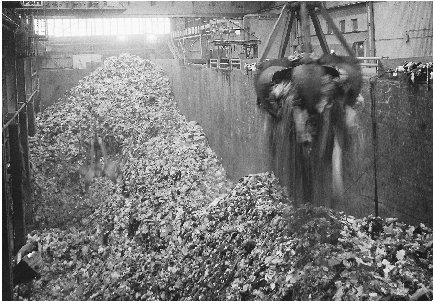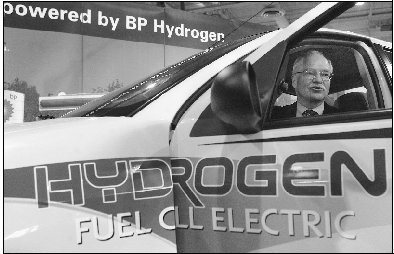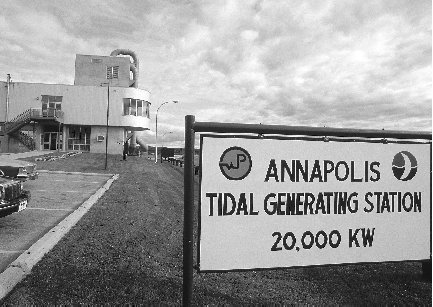Chapter 6
Other Power Alternatives
Solar, wind, hydro, and geothermal power have long been explored by humans as a means for harnessing the energy produced by the natural systems of the earth. Advances in these technologies have started to make each of them a viable alternative to fossil-fuel use. Collectively, these forms of renewable resources account for over 10 percent of the energy produced in the United States. As research and new technology is applied to each one, this percentage is sure to grow.
There are also many other new and intriguing forms of renewable resources that are currently being explored. Some of them are still in the research stages and are not presently making any significant contribution in terms of energy production. Yet they hold immense promise, and energy analysts throughout the world are keeping an eye on their development. Other types of renewable energy sources have gone beyond the research stage and are now being implemented by countries around the world.
OTEC
The ocean is vast. It covers over 75 percent of the earth. The surface waters of the ocean are heated by the energy of the sun. Most of the waters beneath this warm layer remain relatively cold. The abundance of daily sun near the equator creates a significant temperature difference between the warm surface layer of ocean waters and the colder layer below. The vastness of the ocean and the differences in its water temperatures allow it to be used as a renewable source of energy.
An oceanic thermal energy conversion system (OTEC) harnesses the energy of the ocean. An OTEC system is a power plant that is partially submerged in warm, tropical waters. This system relies upon the difference in water temperature between the surface of the ocean and the colder layer below for it to operate. The temperature difference between the surface and the colder layer, which is often about three hundred feet below, can be as much as fifteen to twenty-five degrees Fahrenheit. A tube at the top of the system circulates a liquid such as ammonia, which is heated by the warm surface water on the outside of the tube. The heat changes the ammonia into a gas. This is similar to water being boiled to produce steam. The ammonia gas inside the tube is under a lot of pressure at this point and the pressure turns a turbine generator at the top of the system to produce electricity.
After the ammonia gas pushes past the turbines, it goes into a condenser which uses cold water that is pumped up through a pipe from the bottom layer of the ocean to cool the ammonia inside the tube and return it to a liquid state. The ammonia then runs back into the heating section to repeat the cycle. The design of the system allows the ammonia gas to be used again and again.
An OTEC system is considered a renewable energy source because the temperature differences in the layers of ocean water do not change. The top layer of oceanic water is always warmer and the bottom layers are always colder. The energy is always available to be harnessed by an OTEC system, whether it is used or not.
This type of system is also nonpolluting. Its operation does not require the burning of fossil fuels. It does not produce any chemicals that must be disposed of since all of the chemicals required to operate the system are recycled and remain in the system. OTEC systems are also designed to be located far out in the ocean, causing no noise pollution issues.
A drawback to OTEC systems is the cost of building and operating them. Because all maintenance must be done on-site, a crew must be housed wherever the equipment is located. Crew headquarters and maintenance facilities are built right into the unit's structure, making it much like a small city at sea. The cost of feeding, housing, and paying a crew can offset the profit a utility company may derive from building an OTEC system.
In theory, an OTEC system could continuously generate upward of 160 million watts of electricity. This amount of electricity could supply one hundred thousand homes with all of their energy needs on a daily basis. Yet, a large portion of this electricity needs to be used by the system itself to pump the cool water to the top of the structure. Many scientists feel this makes an OTEC system a poor choice for energy production.
Presently, the concept of OTEC systems is being heavily researched. Japan has shown great interest in developing them to power its coastal cities. The United States has researched sites where an OTEC system may be effective, but plans to construct one are not yet underway. Some energy analysts believe OTEC systems will never become truly competitive with other renewable resources because of the high cost of building and maintaining the units. This, coupled with a low energy output, in comparison to the amount of energy used to run the system itself, may help to explain why OTEC systems have not yet been fully developed, although the concept has been researched for over fifty years.
Tidal Power
Not only is the ocean vast, it is also powerful. Every day the ocean releases huge amounts of energy in the form of tides. These tides are created by the gravitational pull of the moon on the earth's waters. As ocean tides rise, billions of gallons of water are pushed onto the land. As the ocean tide goes out, billions of gallons of water are carried back into the sea. The movement of this amount of water requires a lot of energy. It is this energy that can be harnessed to create electricity.
There are two main ways that have been developed for the energy of tides to be used to produce electricity. The first way requires a large tidal dam, called a barrage, to be built across an estuary with a high tide range. An estuary is an area where a river runs into the ocean. Often an estuary is located at a bay or inlet. Either is a perfect site for a barrage because it is relatively calm and

A barrage is structured like a long cement wall, sometimes over one thousand feet long, with gates in it. The gates are lifted during low tide, which allows water to flow into the estuary as the tide is coming in. When the estuary has filled with water, the gates are lowered and the water can only leave by traveling through turbines in the underwater wall that are connected to generators to produce electricity. La Rance Tidal Power Plant, the largest barrage tidal power station, is located in France. Situated in the estuary of the Rance River as it flows into the English Channel, it is able to produce enough electricity to continuously power fifteen hundred homes.
The second way tides are used to produce electricity requires the building of tidal stream "windmills." These windmill structures are placed in the tidal currents that are along coastlines. The blades of the windmill turn as water pushes past them. The concept is very similar to the generation of electricity using wind power, but because water is much denser than air, the force of a typical tidal movement on a water windmill would be like that of a hurricane on a wind turbine.
When harnessed by barrages and water windmills, the tides are considered renewable resources. The tides of the ocean are forever occurring because it is the pull of the moon and the rotation of the earth that causes them. As long as the moon exists and the world rotates, tidal power can be harnessed.
Barrages and water windmills are nonpolluting sources of energy. There are no fossil fuels being burned to create power. There are also no chemicals involved in producing the electricity. There is not any wastewater emission or air pollution released into the atmosphere. Both barrages and water windmills are considered a green form of energy production.
There are a number of negative aspects to using barrages and water windmills to produce electricity, however. There are few sites in the world that have been developed for this type of power generation, making tidal power one of the world's largest untapped energy reserves. This lack of commitment to the research and development of construction sites is why only France, Canada, and the former Soviet Union are currently producing significant amounts of electricity using tidal power. Both types of tidal power plants are also, at present, very expensive to construct. Ocean waters tend to be corrosive as well and so tidal power plants require ongoing maintenance. All three of these factors make tidal power unattractive to many utility companies.
Due to these challenges, tidal power may never become a major source of electricity for the world, despite its great potential. Yet, this form of energy will be sure to expand to some degree as the fossil fuel reserves continue to be depleted. As new technologies develop, some coastal cities may be able to satisfy a percentage of their energy needs using tidal power.
Biomass
Humans have burned wood as a source of heat for all of recorded history. Wood is a type of biomass, or fuel that comes from burning plant material. There are two different ways to harness the energy released when biomass is burned. Biofuel use can be in the form of direct burning of plant materials, like wood, or using plant materials to produce alcohol that may be burned.
Direct burning of biofuels represents 13 percent of the energy produced in the world. Most of this type of biofuel burning is in the form of wood. Approximately 70 percent of the homes in developing countries use biofuels to heat their homes and to cook food. People in these areas gather firewood as a part of their daily chores and bring it home to be burned. About 20 percent of American homes burn wood as one of their heat sources, while 5 percent of American homes rely solely on firewood as a source of heat. It is understandable why biofuel, in the form of wood, is considered an important part of the world's energy production.
Plant materials, such as sugarcane, seaweed, and corn husks, may also be burned to produce energy. These plant materials are often what are left over after farmers have processed them. Spain has three biofuel power plants that burn the materials left over from processing olive oils and produce enough electricity to power one hundred thousand homes.
Municipal waste can also be burned as a type of biofuel. Municipal waste is all of the garbage that is generated in a home or business. Many cities in Japan, the United States, and western Europe incinerate their municipal waste to make electricity. The heat from burning the refuse is used to boil water into steam. The steam is used to drive turbines that are connected to generators that create electricity. The United States has 110 of these incineration sites. Each of these sites is able to produce enough electricity to power sixty thousand homes. Biofuel in this form plays an important role in American energy production.
Landfills, where garbage is disposed of, produce biofuel as well. Landfills are designed so that the waste materials delivered each day are covered with soil at the end of the day. Waste that is covered in this manner uses anaerobic bacteria to decompose. Anaerobic bacteria produce methane gas as they decompose the waste. Methane gas is highly flammable and may be burned to boil water into steam to power turbines that generate electricity. This type of biofuel use has an additional benefit. Methane gas is one of the most harmful of the greenhouse gases. Burning methane gas to create electricity helps to reduce the amount of methane gas in the atmosphere. Less methane gas means a reduction in the rate of global warming.
Yeast plays a vital role in the formation of another biofuel: ethanol. Yeast uses a process called fermentation to break down plant materials such as grain. Ethanol, a gas produced by yeast as it digests grain, can be burned to generate the heat needed to create steam used in the production of electricity. The country of Brazil relies heavily on ethanol as a biofuel. Many of Brazil's sugarcane processing plants use yeast to digest the leftover plant materials. The ethanol produced is mixed with gasoline to produce gasohol. Almost one-third of the cars in Brazil operate on gasohol. The United States produced 1.5 billion gallons of ethanol fuel in 1999. This ethanol is used to support electricity production and is also used in some motor vehicles in the form of gasohol.
Using biofuels as a source of energy does have some environmental impacts. Whenever any plant material is burned, carbon dioxide is released into the atmosphere. In developed countries there are some regulations intended to help reduce the amount of carbon dioxide released into the atmosphere from burning biofuels.

Another negative aspect of biofuel production is that producing the plant materials needed for biofuels requires a lot of land space. It takes about ten acres of land to produce enough biofuel to match the energy output that one acre of land devoted to solar power production can produce. It is this fact that keeps biofuels from becoming a central focus on the spectrum of renewable energy choices.
Hydrogen
Hydrogen is one of the most abundant elements in the world. It is found everywhere: in the air, the land, and water. Beyond solar power, it is the most unlimited source of energy known to humankind. Unfortunately, it is also proving to be the hardest form of energy to harness.
Hydrogen and oxygen are the two elements that combine to make water. This bond is very strong and it requires a massive input of energy to break apart the hydrogen and oxygen atoms. But once the bond is broken, hydrogen becomes a gas that is highly flammable. Hydrogen gas can be burned to run combustion engines such as those in cars.
The most exciting aspect of hydrogen energy is that when it is burned, it simply recombines with the oxygen in the air to create water. There are no emissions of carbon dioxide or other environmentally damaging gases. Hydrogen power has the potential to be the cleanest form of energy developed by humans.
The process of breaking atoms of hydrogen and oxygen apart, however, requires more energy than can be gained from burning the hydrogen itself. To make hydrogen power a reality, scientists are exploring ways to break apart the water molecules using sources of energy that are abundant and do not damage the environment. They are looking to solar and wind power for outside power. If they are successful, many energy analysts believe hydrogen power will replace fossil fuels as the number one source of energy in the world within the next fifty years.

Scientists have to address more than just the issue of having the energy for separating hydrogen and oxygen if they are to bring hydrogen to the world market. Because hydrogen is a gas, it takes up quite a lot of space, a lot more than gasoline (gasoline is truly a liquid and is only turned into combustible gas vapors by the heat of an engine). Automobiles would have to be designed to carry a large volume of hydrogen gas. The amount of space required means these automobiles would not have a very fuel-efficient design. The energy benefit of using hydrogen would be lost in having to carry the extra weight of a large hydrogen gas tank.
But some researchers have found a solution to this problem. They have redesigned car engines so that instead of burning the hydrogen, it is recombined with oxygen to produce electricity, which the cars use in place of fossil fuels. Automobiles powered in this manner are said to be powered by fuel cells. Vehicles powered by fuel cells are quiet, efficient, and nonpolluting when the hydrogen gas is produced using solar power. Hydrogen is also safer than gasoline because it is completely nontoxic, impossible to contaminate, and if leaked, tends to disperse upward because it is so light. Unlike a gasoline-powered vehicle, there are no moving parts, such as a combustion engine, needed to convert hydrogen to electricity, and so the engine will not wear out.
Fuel cells are difficult to acquire, although the fuel cell market for transportation is growing. The federal government has partnered with several automobile manufacturers to develop concept cars that are highly efficient. This merging of interests, called the Partnership for a New Generation of Vehicles, has, so far, found success. The first of these concept cars was revealed at the North American International Auto Show in January 2000. This car is able to accelerate from zero to sixty miles an hour

Currently, however, cars powered solely on fuel cell energy are still in the development stage. There will have to be many changes in the infrastructure of American gas stations before cars powered by fuel cells can be successfully brought to the open market. Hydrogen will have to be provided as readily as gasoline before the average American consumer is able to buy a fuel cell–powered car. A market for the cars will have to be developed to make production profitable. Once these challenges are overcome, there may be many Americans who will one day be driving cars powered by fuel cells.
The Future for Other Power Alternatives
OTEC, tidal power, biomass, and hydrogen power may all seem unlikely sources of energy, but the technology is already available. None of these forms of power has yet been perfected. Each one has its own set of challenges in development. Each has its own drawbacks. There will need to be a commitment of money, research, and time devoted to furthering these alternative energy sources before they are available as viable energy options for the average consumer.
Yet, each one holds promise for the future. These forms of energy are completely renewable. They do not release harmful pollutants into the environment. Any one of these renewable resources may hold the key to a sustainable future. Together they may each play a small role in making the world a cleaner and healthier place to live for generations to come.
Comment about this article, ask questions, or add new information about this topic: